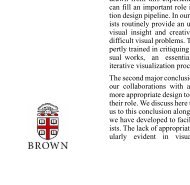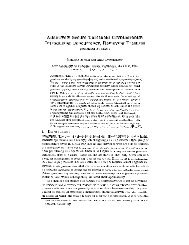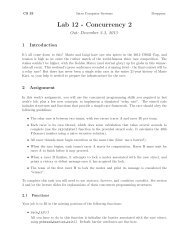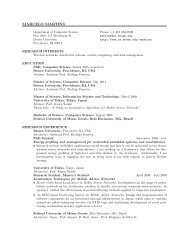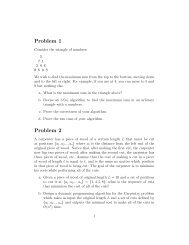Introduction to Color - Brown University
Introduction to Color - Brown University
Introduction to Color - Brown University
You also want an ePaper? Increase the reach of your titles
YUMPU automatically turns print PDFs into web optimized ePapers that Google loves.
CS123 | INTRODUCTION TO COMPUTER GRAPHICS<br />
Recep<strong>to</strong>rs in Retina<br />
<br />
<br />
<br />
<br />
<br />
<br />
Recep<strong>to</strong>rs contain pho<strong>to</strong>pigments that produce electro-chemical response<br />
Rods (sco<strong>to</strong>pic): only see grays, work in low-light/night conditions, mostly in periphery<br />
Cones (pho<strong>to</strong>pic): respond <strong>to</strong> different wavelengths <strong>to</strong> produce color sensations, work in<br />
bright light, densely packed near center of retina (fovea), fewer in periphery<br />
Young-Helmholtz tristimulus theory 1 : 3 cone types in the eye, each of which is most<br />
sensitive <strong>to</strong> a particular range of visible light, with roughly a normal distribution<br />
Three recep<strong>to</strong>r types can produce a gamut of colors that are contained in a 3-space of hue,<br />
saturation and value (lightness/brightness)<br />
To avoid overly literal interpretation of R,G, B, perceptual psychologists often use S<br />
(short), I (intermediate), L (long) as a measure of wavelength instead<br />
1<br />
Thomas Young proposed idea of three recep<strong>to</strong>rs in 1801. Hermann von Helmholtz looked at theory from a<br />
quantitative basis in 1866. Although they did not work <strong>to</strong>gether, the theory is called the Young-Helmholtz theory<br />
since they arrived at same conclusions.<br />
Andries van Dam<br />
<strong>Color</strong> 45/57



